For the recent ARTE documentary about FSC, journalists Manfred Ladwig and Thomas Reutter travelled to Brazil to take a look at pulp company Veracel’s industrial tree plantations. They travel with Klemens Laschefski, professor of political ecology at the Federal University of Minas Gerais.
Laschefski explains that the pulp industry sets up eucalyptus plantations because the tree grows quickly. He adds that it also dries out the soil and leaves no habitat for animals.
Ladwig and Reutter speak to remote sensing scientist Matthew Hansen in his office in Maryland University. Hansen looks at the plantations on his computer screen. The blue areas are plantations and the pink areas are plantations that have been logged and replanted.

Hansen gives his opinion about FSC certifying industrial tree plantations like Veracel’s:
“It’s a contradiction in terms, if it literally was founded to combat monocultures, now monocultures are certified, this is a logical fallacy. It doesn’t make sense. So, I don’t agree with that.
“I do agree that you have to have your pulp, paper, timber land uses somewhere, because we all use these products. And I don’t think it’s a hard argument to make that in this time in our history it shouldn’t be replacing natural forest.”
This is a view shared by the World Rainforest Movement. Back in 2008, when Veracel was first certified by SGS Qualifor, WRM described the certification of Veracel as FSC’s “death certificate”.
Stora Enso’s lie
Veracel is owned by the Brazilian company Fibria (previously called Aracruz) and the Swedish-Finnish company Stora Enso. In a response to the documentary on its website, Stora Enso states that, “All Veracel’s tree plantations were established on degraded pasture lands, and no rainforest has been converted into plantations.”
That is a lie. Veracel first arrived in Bahia in 1992, in the form of a company called VeraCruz Forestal. When Brazilian NGOs saw what the company was doing to the forests, they protested, as did the Union of Forest Workers.
In February 1993, the Ministry of Environment temporarily suspended VeraCruz Florestal’s operations for breaching the law on protection of the mata atlantica – the extremely biodiverse Atlantic Forest.
The company drove bulldozers through the forest, attaching chains between the bulldozers to clear the forest. These photographs, taken in 1992, clearly show the destruction of forests to make way for Veracel’s plantations:
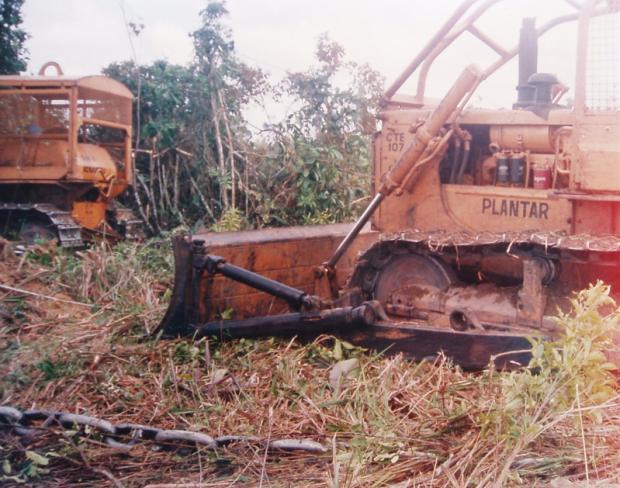


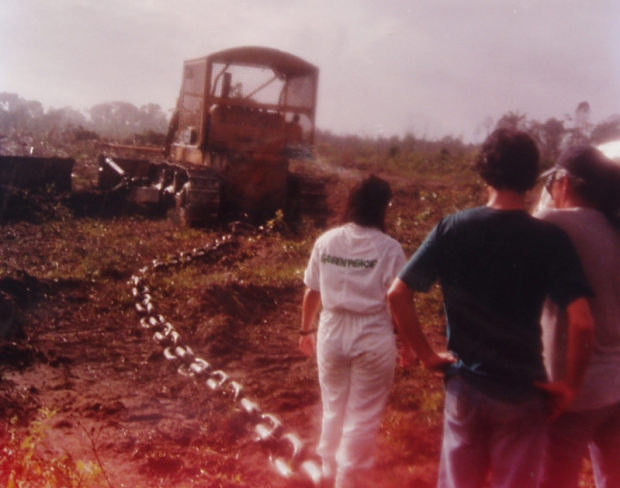
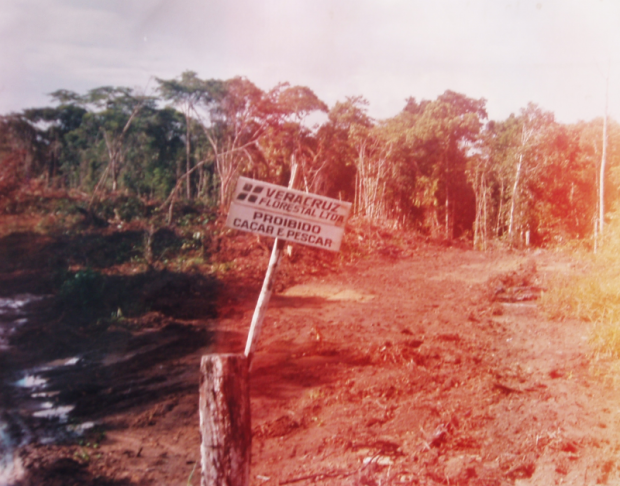
Ongoing land conflicts
The most recent FSC assessment report for Veracel, carried out by Rainforest Alliance, states that there were land conflicts with local communities in the past. But according to Rainforest Alliance these have now been resolved.
In fact, the land conflicts continue. Ladwig and Reutter visit a village called Paradiso. The land belongs to the Catholic Church, but Veracel has planted eucalyptus where the villagers used to plant their food crops. Veracel’s eucalyptus trees are right behind their houses. And the eucalyptus trees suck the water away from all other plants.
One of the villagers tells Ladwig and Reutter that the police have a close relationship with Veracel. One time, the police violently evicted from their homes, without warning, and without a court order. The police made them leave. “They treated us like bandits, and took us to the police station,” one of the villagers says.
The villagers are now struggling from one harvest to the next to survive.
“Veracel took our land,” the villagers say. They are taking Veracel to court to try to get their land back.
As usual, Kim Carstensen, FSC’s director general, sides with the company – and against the local community. He tells Ladwig and Reutter that,
“Land rights in Brazil is a very, very complicated issue. There’s a court case ongoing, as long as the court case is ongoing, and Veracel is sort of legally holding the land, there’s no problem with the certificate, obviously. Once the court case has been decided, depending on what the outcome will be, then of course we expect Veracel to follow the outcome of the court case.”
It’s true that land rights is a complicated issue. It’s also true that Veracel and other pulp companies in the south of Bahia have exacerbated the land rights issue by taking over a vast area of land.
Laschefski is convinced that Veracel has taken the villagers’ land:
“It’s simply unbelievable that people here fight for their land so that they can eat, and its occupied by a company that produces toilet paper for us in Europe. I can’t get my head around that, as much as I try. That really upsets me. That makes me really sad.”
Veracel has taken Indigenous Peoples’ livelihoods
They drive to an indigenous village near the coast. The indigenous people also say that Veracel has taken their land for its eucalyptus plantations. The head of the village, Nailton Pataxó-Hãhãhãe, tells them that there was a hearing, before Veracel started its plantations, but that Veracel got a headman from a village that lives from tourism to speak. And that headman said that he agreed with everything the company was doing.
“He was bought by Veracel,” Nailton says.
The indigenous people say that Veracel has taken their livelihoods. They say that they feel as though they are being wiped out by eucalyptus.
Ladwig and Reutter drive together with Laschefski to a village called Nueva Esperanza. In 2016, World Rainforest Movement reported that Veracel was trying to evict the Pataxó indigenous people from the village.
When they get there, the village is almost deserted. They meet Maria de Lourdes Fonseca de Oliveira, one of the few people still living there. She tells them that the Pataxó rented their land to Veracel. “That was a mistake,” she says. Now Veracel will not give the land back.
She describes FSC as “a lie”, and adds, “The only thing that’s true is that Veracel pollutes the land and the water. And there are no birds or animals any more here. Veracel brings death.”
Ladwig and Reutter want to interview Veracel to get the company’s version of events. The certifying body offered to give an interview, and Ladwig and Reutter booked a flight to Sao Paulo. But then the certifying body cancelled the interview.
They drive to the Veracel headquarters to confront the company with what they have seen and heard. They had been in email contact with the company for weeks and had told the company when they would arrive at the headquarters. But the company’s PR organisation told them that no one had time for an interview.
FSC’s Carstensen tells Ladwig and Reutter that,
“Veracel is a company that has been checked every single year since they got certified in 2008. We have had several investigations into the claims that were, that came from different stakeholders, and the certificate as far as we can see is still completely valid. And there are a lot of good things to say about Veracel.”
Carstensen’s response perfectly highlights what is wrong with the FSC certification system. Despite the yearly audits and investigations, FSC can see none of the problems caused by Veracel’s vast monocultures.
I visited Veracel’s plantations in 2005. Talking to the people whose villages were now surrounded by eucalyptus plantations, the impacts on their livelihoods were clear.
One of the villagers told me, “There are no jobs here now and no money from the eucalyptus.”
This, then, is the type of industrial tree plantation operation that FSC considers to be worthy of its certificate:
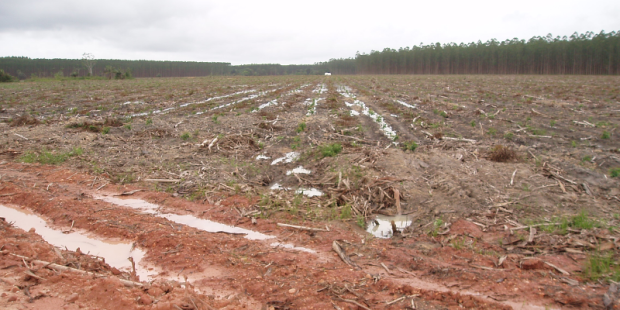


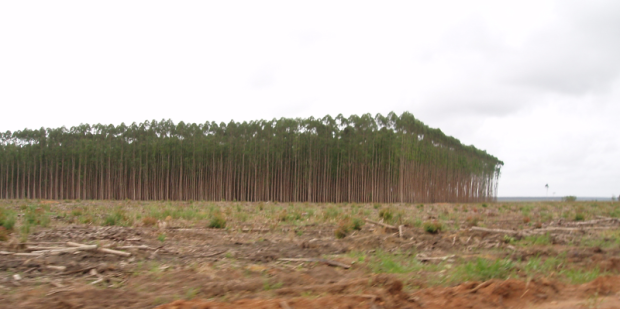

PHOTO Credits: The images of Matthew Hansen and Kim Carstensen are screenshots from the ARTE documentary.
This is the seventh post in a series based on ARTE’s documentary about FSC: “The exploitation of primary forests: Can an ecolabel stop the forest industry?”
The documentary is available here.
